RackTables - clearly and in detail about what is installed in the racks
Dear Habra community, let me bring to your attention the RackTables web application . Immediately make a reservation that I am not the author of this miracle, but only a satisfied user. A search in the hub did not return a single article about RackTables, therefore I correct this omission and publish a short review.
A typical situation. The administrator (or group of admins) in the farm has more than one equipment rack - servers, routers, disk shelves and arrays, PDUs, and so on. It is logical to assume that it is necessary to have information about what is where, what services are spinning, and how many hard drives are there in that server. The easiest way to record server hardware is some kind of nameplate in excel. But it is not interesting. Statically, beloved. Not web-two-zero. But in RackTables ...
With Racktables you can:
Well and besides, objects can be attached files, access to the interface can be limited, and thanks to a flexible system of tags, you can mark anything.
The project is young, open-source. At the moment, the stable version is 0.19.4. Written in php.
No particular difficulties should arise. For the application to function, you need a LAMP server. The RackTables archive must be unpacked in / var / www / racktables and run from the browser:
The installation wizard will tell you what to do next.
The application interface is concise and convenient. Hereinafter, for demonstration, I will use a demo instance of the application, which can be accessed from the developer's site.
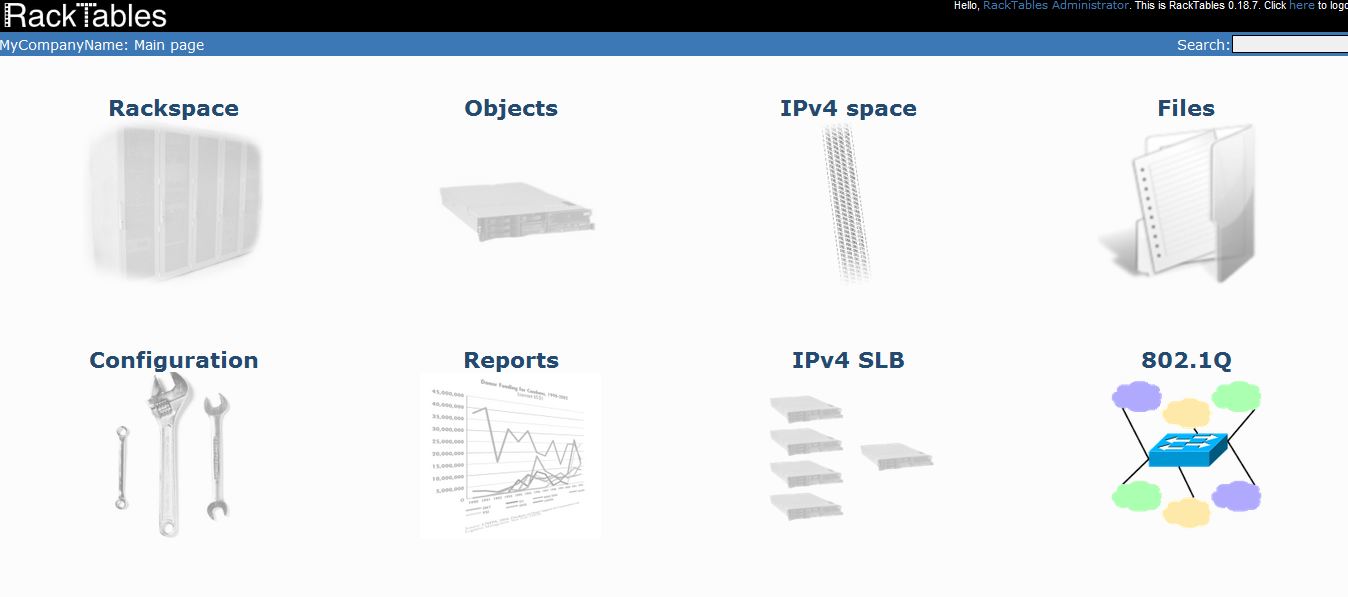
Let's go in order. Behind the Rackspace icon is the most interesting. This feature I like the most:

Almost all interface elements are clickable. You can select a separate row of racks. By clicking on a separate rack, you can see its fullness.
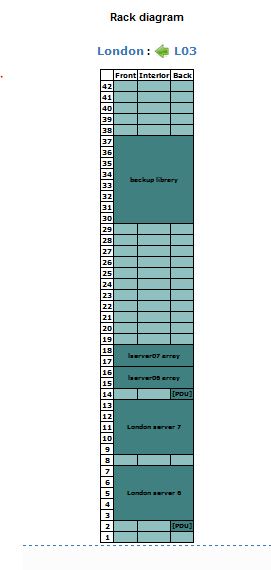
Again, you can click on the server and already enjoy the detailed information about it.

Well and so on ad infinitum. Further, you can delve into the details of network settings, and by clicking on the server model, see all such objects. The same goes for the rest of the details of the object, highlighted as a hyperlink.
I think this is enough to appreciate the interface.
Now about customization.
Firstly, the list of attributes of the object is edited. You can create your own, edit existing ones. RackTables has its own dictionary, which is also edited at your discretion. The dictionary contains models of devices, from servers to rack-mount power supplies. You can create your own types of objects and again assign your own attributes to them.
For example, I needed to somehow logically separate the two Solaris domains living on the same SUN sparc enterprice M5000. Moreover, this is not a zone, namely the hardware domain. RackTables did not have this type, but it was easily created.
Tags can be attached to each object. Then using these tags it’s convenient to filter the contents of RT. Tags also play an important role in delimiting access to RackTables - it is for them that users are allowed or restricted access to objects.
I am afraid that I have not studied it well enough, because I can’t tell you a lot. Because here are just a few more screenshots of RackTables.
Networks:
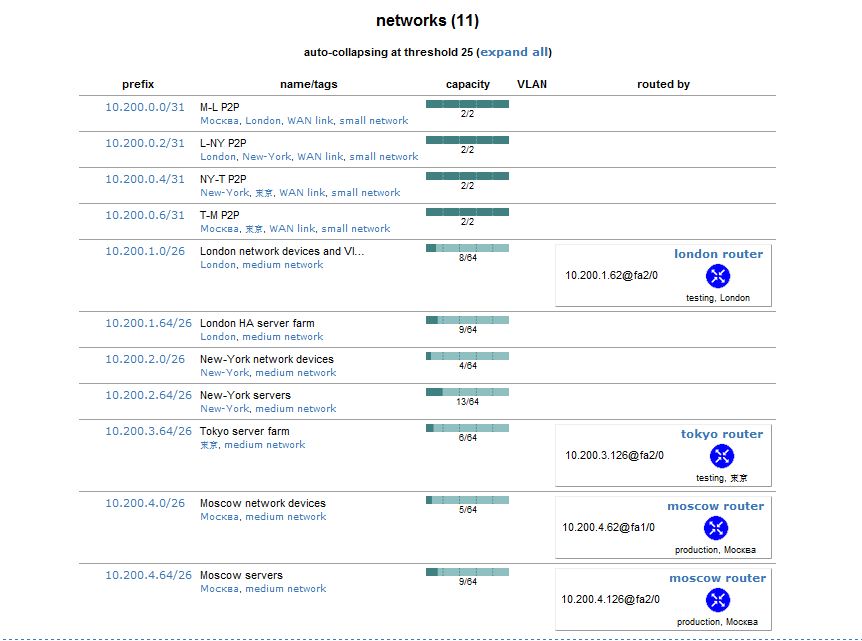

SLB:
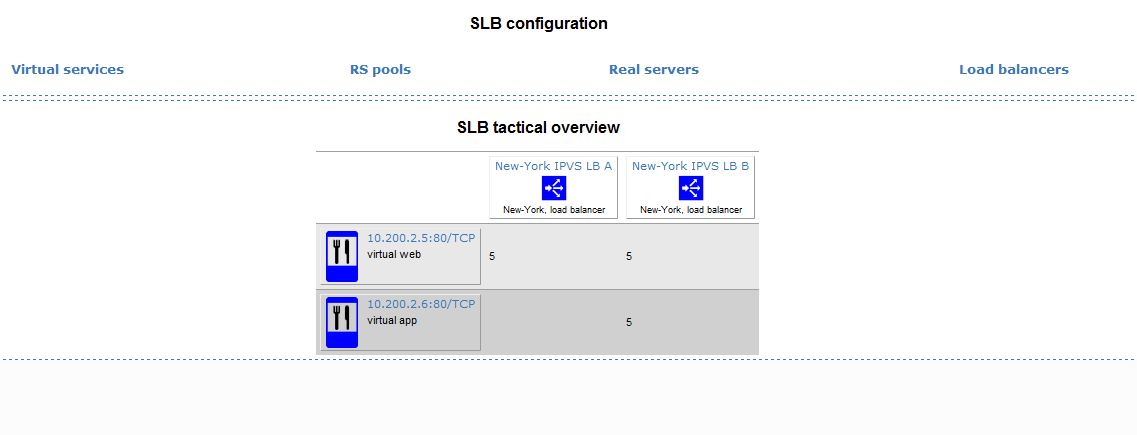
Reports:

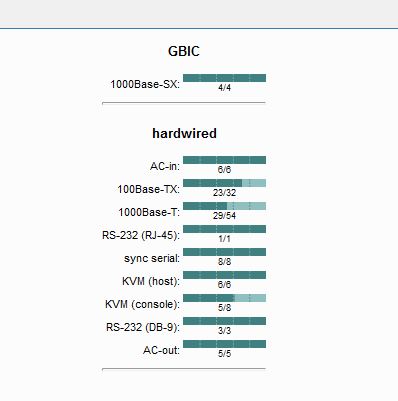
RT replaced me with the notorious excel with a bunch of columns, it allowed me to quickly solve questions like “where should we put new equipment?” and "how many% Model_Name% servers do we have?"
Of the shortcomings, I can only note the lack of the ability to visually place the blade servers in the basket. But as I understand it, the authors took this into account and, I hope, will soon be pleased with the update.
Of the analogues, I found a couple more applications:
RackMonkey
Avocent Data Center Planner
The first is also open-source, but not so actively developed, the second costs money.
Why do I need this?
A typical situation. The administrator (or group of admins) in the farm has more than one equipment rack - servers, routers, disk shelves and arrays, PDUs, and so on. It is logical to assume that it is necessary to have information about what is where, what services are spinning, and how many hard drives are there in that server. The easiest way to record server hardware is some kind of nameplate in excel. But it is not interesting. Statically, beloved. Not web-two-zero. But in RackTables ...
Application features
With Racktables you can:
- Make a list of available equipment, server racks (cabinets)
- "Mount" the iron in the rack
- Contain a list of physical port devices (any) and links between them
- Have a list of networks and ip addresses, assign addresses to devices
- List NAT Rules
- Describe policies and settings for load balancing systems
Well and besides, objects can be attached files, access to the interface can be limited, and thanks to a flexible system of tags, you can mark anything.
The project is young, open-source. At the moment, the stable version is 0.19.4. Written in php.
Installation
No particular difficulties should arise. For the application to function, you need a LAMP server. The RackTables archive must be unpacked in / var / www / racktables and run from the browser:
your_servers_ip_address/racktables/install.phpThe installation wizard will tell you what to do next.
Using
The application interface is concise and convenient. Hereinafter, for demonstration, I will use a demo instance of the application, which can be accessed from the developer's site.

Let's go in order. Behind the Rackspace icon is the most interesting. This feature I like the most:

Almost all interface elements are clickable. You can select a separate row of racks. By clicking on a separate rack, you can see its fullness.

Again, you can click on the server and already enjoy the detailed information about it.

Well and so on ad infinitum. Further, you can delve into the details of network settings, and by clicking on the server model, see all such objects. The same goes for the rest of the details of the object, highlighted as a hyperlink.
I think this is enough to appreciate the interface.
Now about customization.
Firstly, the list of attributes of the object is edited. You can create your own, edit existing ones. RackTables has its own dictionary, which is also edited at your discretion. The dictionary contains models of devices, from servers to rack-mount power supplies. You can create your own types of objects and again assign your own attributes to them.
For example, I needed to somehow logically separate the two Solaris domains living on the same SUN sparc enterprice M5000. Moreover, this is not a zone, namely the hardware domain. RackTables did not have this type, but it was easily created.
Tags can be attached to each object. Then using these tags it’s convenient to filter the contents of RT. Tags also play an important role in delimiting access to RackTables - it is for them that users are allowed or restricted access to objects.
I am afraid that I have not studied it well enough, because I can’t tell you a lot. Because here are just a few more screenshots of RackTables.
Networks:


SLB:

Reports:


Summary
RT replaced me with the notorious excel with a bunch of columns, it allowed me to quickly solve questions like “where should we put new equipment?” and "how many% Model_Name% servers do we have?"
Of the shortcomings, I can only note the lack of the ability to visually place the blade servers in the basket. But as I understand it, the authors took this into account and, I hope, will soon be pleased with the update.
Of the analogues, I found a couple more applications:
RackMonkey
Avocent Data Center Planner
The first is also open-source, but not so actively developed, the second costs money.
